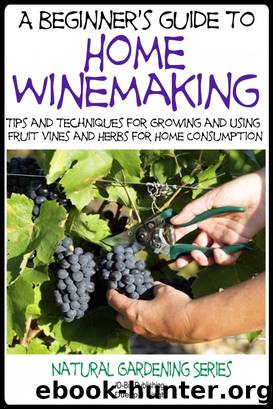A Beginner's Guide to Home Winemaking by Dueep J. Singh

Author:Dueep J. Singh
Language: eng
Format: epub
Tags: wine, grapes, winemaking, home winemaking, vinyards
Publisher: JD-Biz Corp Publishing
Making the Fermentation Mixture
Adding sugar – you can use either white or refined castor sugar, which is the most suitable sugar for winemaking, as it dissolves readily. In olden times, granulated sugar, or even honey was used. Brown sugar and demerara sugar was used by the ancients to get their versions of wine and because nobody chemically extracted white sugar in those ancient far off good old days.
Do not use this brown sugar or any colored sugar for delicately flavored juices. This is going to give a good brown and golden color to your wine.
Add the sugar gradually and keep stirring until it is thoroughly dissolved. When making sweet and heavy wine add the sugar in three parts, with an interval of three days between each. The usual quantity is 2 pounds sugar to each gallon of fruit and vegetable juice for a dry wine, 2 ½ pounds for a medium wine and 3 ½ to 4 pounds for a sweet wine.
Adding yeast – although there may be natural yeast on the fruit, it is always best to add a specific quantity of yeast to the extract.
If you are using Baker’s or Brewers compressed yeast, mixed ¾ ounce yeast to a cupful of juice and make it a creamy mixture. This is then added to each gallon of Must. Stir thoroughly because this is going to ferment the juice.
For more satisfactory results, you can look for proper wine yeast. These are going to help your wines carry a better bouquet and a higher percentage of alcohol. They are quick to clear, have a stiffer sediment and also they store better.
http://www.amazon.com/Packs-Lalvin-Dried-EC-1118/dp/B003TOEEFG
This is good for beginners.
You can get a large variety of yeast in the market today, including Sherry, champagne, Burgundy, Madeira, hope, clarity, and all-purpose. Choose the yeast most suitable to the fruit. For a limited quantity of wine, use all-purpose or neutral yeast.
Some special yeast, which are available in liquid or dry form have to be made active by growing them in fresh fruit juice before adding them to the Must. I normally do that in order to activate the yeast. Just put about 3 teaspoons full in 250 mL of juice. Keep it for 48 hours. You should see the juice bubbling at the end of the 48 hours. That means the yeast is active. That means all the yeast in the packet, depending on the recipe can be poured into the Must.
If you are using fresh fruit juice where I am good if you cannot find it easily available. Make a special yeast feeding mixture by dissolving one tablespoonful of malt extract in half a pint of water. Stir in 1 tablespoon full of granulated sugar until it is dissolved and the juice of one lemon. Bring this mixture to a boil; allow cooling and adding the yeast for fermentation. If the yeast is properly developed, it can then be used for more than four weeks.
It is very important to heat the juice – Must – to between 65 and 75°F – 18 to 21°C before stirring in the yeast of any sort.
Download
This site does not store any files on its server. We only index and link to content provided by other sites. Please contact the content providers to delete copyright contents if any and email us, we'll remove relevant links or contents immediately.
Whiskies (Collins Gem) by dominic roskrow(42211)
101 Whiskies to Try Before You Die by Ian Buxton(42178)
Whiskies Galore by Ian Buxton(40330)
Craft Beer for the Homebrewer by Michael Agnew(17445)
Right Here, Right Now by Georgia Beers(3497)
Not a Diet Book by James Smith(2725)
Water by Ian Miller(2582)
The Coffee Dictionary by Maxwell Colonna-Dashwood(2531)
Kitchen confidential by Anthony Bourdain(2306)
Coffee for One by KJ Fallon(2007)
Smuggler's Cove: Exotic Cocktails, Rum, and the Cult of Tiki by Martin Cate & Rebecca Cate(1979)
Beer is proof God loves us by Charles W. Bamforth(1920)
Superfood Smoothie Bowls: Delicious, Satisfying, Protein-Packed Blends that Boost Energy and Burn Fat by Chace Daniella(1901)
Talking as Fast as I Can by Lauren Graham(1832)
Bourbon: A Savor the South Cookbook by Kathleen Purvis(1791)
A Short History of Drunkenness by Forsyth Mark(1719)
Eat With Intention by Cassandra Bodzak(1687)
Cocktails for the Holidays by Editors of Imbibe magazine(1626)
Colombia Travel Guide by Lonely Planet(1609)
